ISSN ONLINE(2319-8753)PRINT(2347-6710)
ISSN ONLINE(2319-8753)PRINT(2347-6710)
S Rehan Ali1, R K Jain2
|
| Related article at Pubmed, Scholar Google |
Visit for more related articles at International Journal of Innovative Research in Science, Engineering and Technology
Over the years, the rising population, growing industries and expanding agricultural practices have raise the demand of water supply. Monsoon is still the main hope and source of our agriculture. Hence water conservation had become need of the time. Rainwater harvesting is a way to capture the rainwater at the time of downpour, store that water above the ground or charge the underground water and use it later. As the groundwater resources are depleting, the rainwater harvesting is the only way to solve the water problem. Rainwater harvesting will not only be helpful to meet the demand of water supply but also be helpful to improve the quantity and quality of water. Here, in this paper our focus is to design a tank to store rainwater from rooftop of the building to cater the need of water requirement for College of Engineering, Teerthanker Mahaveer University, Moradabad.
Keywords |
| water, monsoon, rainwater harvesting, groundwater, demand, population |
I. INTRODUCTION |
| One of the biggest challenges of the 21st century is to overcome the growing water shortage. Rainwater harvesting (RWH) has thus regained its importance as a valuable alternative or supplementary water resource, along with more conventional water supply technologies. Water shortages can be relieved if rainwater harvesting is practiced more widely. People collect and store rainwater in buckets, tanks, ponds and wells. This is commonly referred to as rainwater harvesting and has been practiced for centuries. Rainwater can be used for multiple purposes ranging from irrigating crops to washing, cooking and drinking. Rainwater harvesting is a simple low-cost technique that requires minimum specific expertise or knowledge and offers many benefits. Rainwater harvesting is one of the alternative technology for delivering drinking water. In fact, through the ages, this has been a traditional way of enhancing domestic water supply. Rainwater harvesting systems are viable options both for storing water for domestic use and for recharging groundwater aquifers. |
| Nature has endowed India with huge water resources. We have perennial rivers like Ganga, Brahmaputra, Yamuna, Beas and other along with their tributaries and distributaries besides in North and Eastern India, we have spring and rain fed rivers in central and peninsular India. The major rivers among these are Godavari, Krishna, Narmada, Tapti and Kaveri. These huge potential water resources notwithstanding, we are facing a water crisis across the country. Over the years, rising population, growing industrialization and expanding agriculture have pushed up the demand for water. Monsoon is still the main hope of our agriculture. |
| Water conservation has become the need of the day. Rainwater harvesting is a way to capture the rainwater at the time of downpour, store that water above the ground or charge the underground water and use it later. This happens in open areas as well as in congested cities through the installation of required equipment. The collection and storage of rainwater from run-off areas such as roofs and other surfaces has been practiced since ancient times in India. It is particularly useful where water supply is inadequate. |
| Cherrapunji was famous for receiving volume of rainfall in the world, and it still is, but experience acute water shortage as a result of extensive deforestation and due to non conservation of water from different resources. Free flow of water along the slopes of hills has caused heavy erosion of top soil. There are now many stretches devoid of trees and greenery. People have to walk long distances to collect water. If rainwater harvesting had been used, things would have been different. |
II. STUDY AREA |
| College of Engineering, Teerthanker Mahaveer University, is located in the Moradabad, a small town in the western part of the state of the Uttar Pradesh, in northern India. The geographical area of the Moradabad is 70 sq. Km. The city is situated in western U P between 280 21’ to 28016´ Latitude North and 780 4´ to 790 Longitude East. It has an average elevation of 186 meters. The total population of the city is 27, 61,620 out of which males are 14, 94,220 and females are 12, 67,400. It lies within the great Gangetic plain, and is demarcated into three subdivisions with an elevation slightly greater than the plain below, and is traversed by numerous steams descending from the Himalayas [1] and [2]. There is great demand of water in college of engineering mainly for laboratories used in Civil Engineering, Mechanical Engineering, Chemical Engineering, Chemistry, Physics etc., for use in cleaning the building floors, labs as well as classes, for use in horticulture purpose also, for sprinkling the water in dry land of C.O.E especially in summer season for preventing the soil dust particle in air etc. |
| The reasons for collecting and using rainwater for domestic use are plentiful and varied. The increased need for water results in lower groundwater tables and depleted reservoirs. Many piped water supply systems fail. The use of rainwater is a useful alternative to provide continuous flow of water for the students and Laboratories. |
| There is great demand of water in college of engineering mainly for laboratories used in Civil Engineering, Mechanical Engineering, Chemical Engineering, Chemistry, Physics etc., for use in cleaning the building floors, labs as well as classes, for use in horticulture purpose also, for sprinkling the water in dry land of C.O.E especially in summer season for preventing the soil dust particle in air etc. |
| The reasons for collecting and using rainwater for domestic use are plentiful and varied. The increased need for water results in lower groundwater tables and depleted reservoirs. Many piped water supply systems fail. The use of rainwater is a useful alternative to provide continuous flow of water for the students and Laboratories. |
III. OBJECTIVES |
| This project is carried out to cater the need of the College of Engineering, Teerthanker Mahaveer University. This project will not only be helpful to fulfil the need of water supply to our college but also to provide water to faculty residing in the Campus. |
| The increased need for water may result in lowering the groundwater table and depleted reservoirs. Hence the use of rainwater will be a useful alternative to provide continuous water supply for our students and laboratories. |
| The water stored from the rainwater will also be of good quality i. e. free from impurities which might be there in groundwater of Moradabad as it is having large number of brass industries & e-waste. |
| Keeping in mind the (i) increasing water demands, (ii) quality of water supply, (iii) variations in water availability and (iii) advantages of collection and storage of rainwater near the place of use etc, it was planned to design the rain water harvesting system for the College of Engineering. |
IV. PROPOSED METHODOLOGY |
| A) Environment Considerations: Environment feasibility depends on the amount and patterns of rainfall in the area, the duration of dry periods and the availability of other water sources. The rainfall pattern over the year plays a key role in determining whether RWH can compete with other water supply systems. Tropical climates with short (one to four months) dry season and multiple high intensity rainstorms provide the most suitable conditions for water harvesting. In addition, rainwater harvesting may also be valuable in wet tropical climates (e.g. Bangladesh), where the water quality of surface water may vary greatly throughout the year [1]. |
| As a general rule, rainfall should be over 50mm/month for at least half a year of 300 mm/year (unless other sources are extremely scarce) to make RWH environmentally feasible [1]. |
| B) Technical Aspects: The construction of a RWH system is determined by several technical factors as [3]: |
| a) Use of impermeable roofing material such as iron sheets, tiles, asbestos- cement. |
| b) Availability of an area of at least 1 m2 near each house for constructing a storage tank. |
| c) Water consumption rate (number users and types of uses) and storage capacity required. |
| d) Availability of other water sources, either groundwater or surface water that can be used when stored rainwater runs out. |
| e) Availability of labour with technical building skill in or nearby the community. |
| f) Availability of required, suitable local construction material and labour. |
| C) Water consumption and water management :Water consumption for the college of Engineering, Teerthanker |
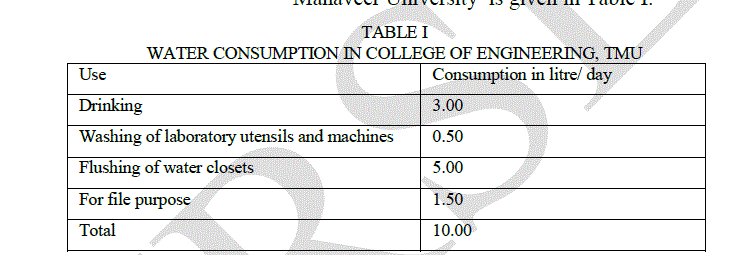 |
| Compiled from various sources [1] Total amount of rain water harvested = Rainfall (mm) x Area of catchment x |
| Runoff coefficient harvestment system |
| D) Design a rainwater harvesting system: Three main steps to be followed in designing a RWH system as [4] and [5] |
| a) Determine the total amount of required and available rainwater |
| b) Design of catchment area |
| c) Design of delivery system |
| d) Design of storage reservoir |
| a) Total amount of required and available rainwater: To estimate water demand the following equation can be used |
| Demand= Water Use x Household Members x 365 days |
| The water demand of COE if the average water use per person is 10 litres per day and the Institute has 2200 family members , then Demand = 10 litres x 2200 member x 365 days= 8000000 litre per year. Rainwater data of Moradabad for last five years is shown in Table II |
 |
 |
| Source : CGWB,Moradabad [1] & [6] |
| So the average rainfall for Moradabad taken from above table = 80 mm |
| So we consider the average rain fall for Moradabad 100 mm considering for Future |
| Calculating potential rainwater supply by estimating run-off (S) = R x A x Cr |
| Where S= Mean annual rainwater supply (m3) |
| R= Mean annual rainfall (m) |
| A= Catchment area (m2) |
| Cr= Run-off coefficient |
| S= 0.1m/year x 4810.425 m2 x 0.8 = 380.83 m3/year = 1186/day |
| Runoff Coefficient for traditional roofing materials is 0.6-0.9 , considering as an average value 0.8 |
| b) Design of catchment area: From the Drawing of Terrace Floor, we have calculated the total roof top area of College of Engineering (COE) = 51725 sq ft = 4801.425 m2 |
| Design of storage reservoir [4] and [5] Capacity |
| Free Board =200 mm |
| Depth of top ring beam = 600 mm |
| Inner diameter tank at the ring beam = 12000 mm |
| Thickness of vertical wall at top= 100 mm |
| Thickness of vertical wall at the bottom = 300 mm |
| Thickness of 1:4:8 P.C.C base course =100 mm |
| Let the height of vertical wall be h meter. |
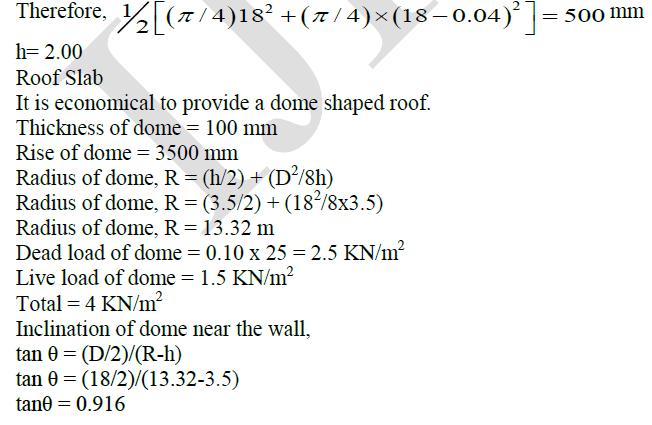 |
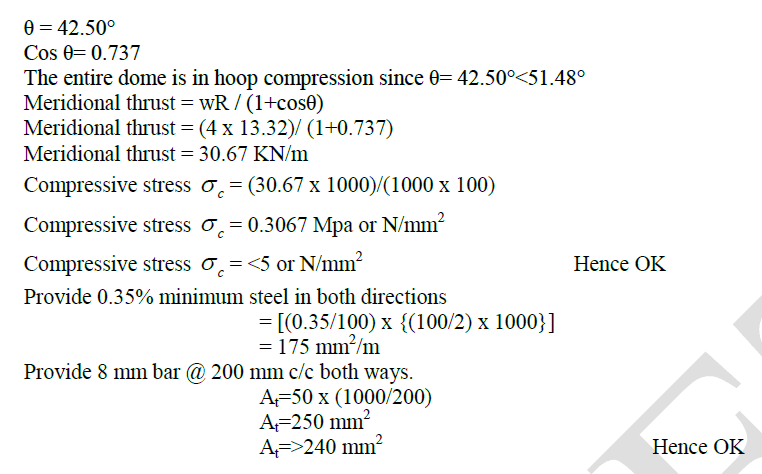 |
| Provide a ventilator of 900mm diameter at the middle of the dome. Provide a ring beam of 150 x 150 along with 4 - 8 mm hoop bars. Also, provide 8 mm ties @ 300 mm c/c. Similarly, provide a manhole of 600 x 600 mm 2 near the walls. |
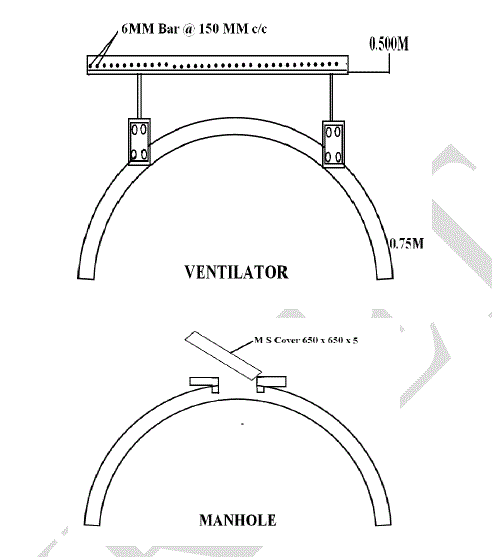 |
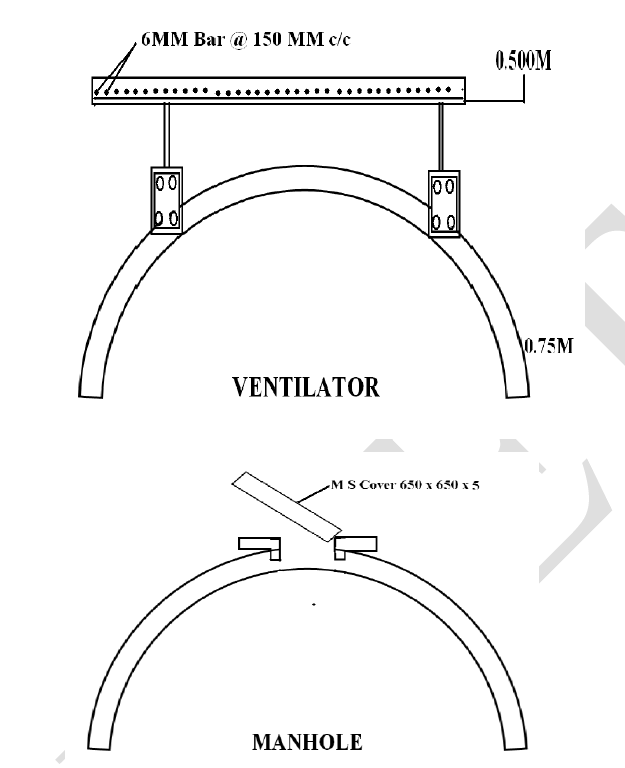 |
| Clear cover to the bottom reinforcement in the base slab should be 40 mm elsewhere it should be 25 mm |
| Fig.1 Detailed Drawing Plan & Elevation of Rain Water harvesting Tank [7] |
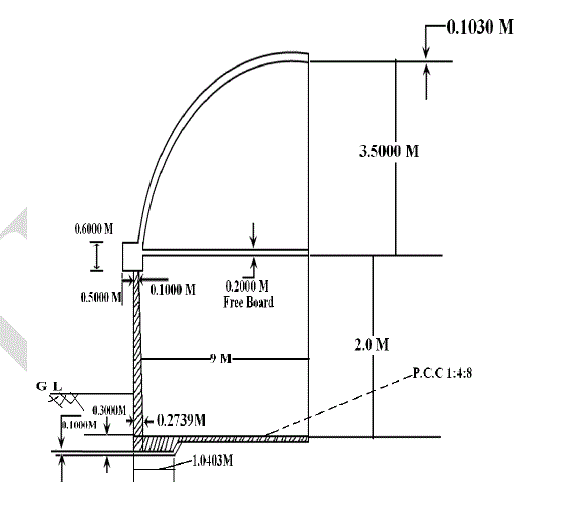 |
 |
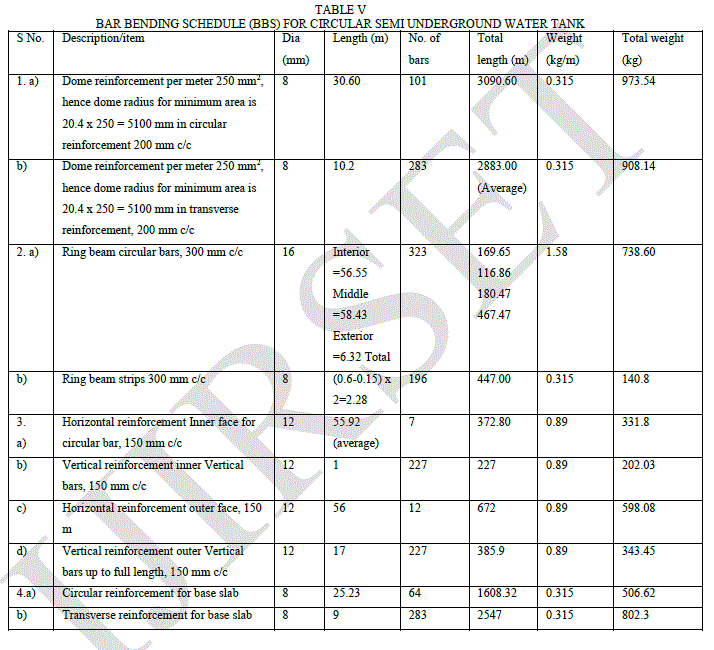 |
 |
| The total cost of the project is Rs. Nine lac fifty nine thousand six hundred eighty six as shown in table IX. |
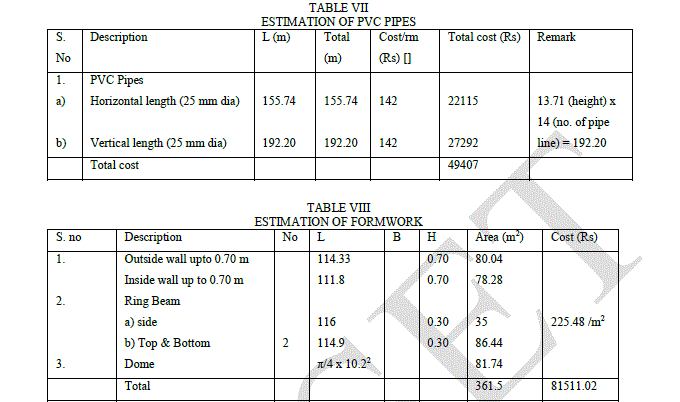 |
V. CONCLUSION |
| On the basis of water requirement of the college, groundwater conditions of the area and rainwater data, it is proposed to develop rainwater harvesting system for catering the need for water for the College of Engineering. It will not only maintain the water level of the groundwater of the region but also save our water resources and power consumption for future use. |
ACKNOWLEDGMENT |
| This work reflects a part of project work carried out by the authors. We are thankful to the principal, College of Engineering, TMU and also thankful to Central Groundwater Board, Ministry of Water Resources, Govt. Of India for providing the rainfall data and technical report related to groundwater aquifer conditions of Moradabad. We are also very thankful to U. P. Public Works Department (PWD) for providing schedule of rates for Moradabad Circle. |
References |
|